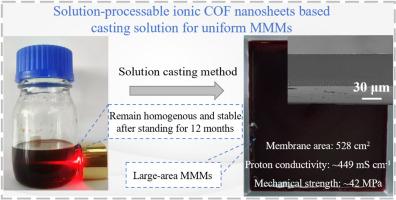溶液可加工离子共价有机框架纳米片用于增强质子导电性的坚固混合基质膜
IF 7.9
2区 工程技术
Q1 CHEMISTRY, PHYSICAL
引用次数: 0
摘要
具有坚固性和高质子导电性的质子交换膜(PEMs)仍然是稀缺的。本研究将可溶液处理的磺化共价有机骨架(COF)纳米片用作功能填料,并将其掺入磺化聚醚砜(spe)基质中,制备混合基质膜(MMMs)。值得注意的是,由磺化COF纳米片和spe组成的混合铸造溶液表现出优异的稳定性(在12个月内没有沉淀/团聚),这主要是由于电荷引起的静电排斥。由上述高度稳定的铸造溶液制备的优化mm,具有均匀的填料分散和优异的填料-聚合物界面相容性,具有高机械强度(~ 36 MPa)和优异的质子导电性(~ 453 mS cm - 1, 70°C, 95% RH)。MMMs前所未有的性能主要得益于功能填料的优异的溶液可加工性,这使得混合溶液均匀且具有优异的稳定性,从而最大限度地减少了在膜制备过程中填料团聚的不利影响。利用稳定铸造溶液的独特优势,可以很容易地制备出具有相当性能(~ 42 MPa, ~ 449 mS cm - 1, 70°C, 95% RH)的大面积mm (528 cm2)并在燃料电池中进行测试。各种mm的成功制备验证了该方法的通用性。这项工作为mm的制备提供了一个新的路线图,代表了其更广泛应用的关键一步。本文章由计算机程序翻译,如有差异,请以英文原文为准。

Solution-processable ionic covalent organic framework nanosheets for robust mixed matrix membranes with enhanced proton conductivity
Proton exchange membranes (PEMs) with robustness and high proton conductivity remain scarce. Here, solution-processable sulfonated covalent organic framework (COF) nanosheets are used as functional fillers and incorporated into a sulfonated polyethersulfone (SPES) matrix to prepare mixed matrix membranes (MMMs). Remarkably, the mixed casting solution comprising sulfonated COF nanosheets and SPES demonstrates exceptional stability (no sedimentation/agglomeration over 12 months), primarily due to charge-induced electrostatic repulsion. The optimized MMMs, prepared from the above highly stable casting solution, demonstrate uniform filler dispersion and excellent filler-polymer interfacial compatibility, achieving both high mechanical strength (∼36 MPa) and superior proton conductivity (∼453 mS cm−1, 70 °C, 95 % RH). The unprecedented performance of MMMs mainly benefits from the excellent solution processability of the functional fillers, which enables a uniformly mixed solution with superior stability, thereby minimizing adverse effects of filler agglomeration during membrane preparation. Leveraging the unique advantages of the stable casting solution, large-area MMMs (528 cm2) with comparable performance (∼42 MPa, ∼449 mS cm−1, 70 °C, 95 % RH) are readily prepared and tested in fuel cell. The successful preparation of various MMMs validates the generality of this method. This work offers a new roadmap for preparing MMMs, representing a critical step toward their broader application.
求助全文
通过发布文献求助,成功后即可免费获取论文全文。
去求助
来源期刊

Journal of Power Sources
工程技术-电化学
CiteScore
16.40
自引率
6.50%
发文量
1249
审稿时长
36 days
期刊介绍:
The Journal of Power Sources is a publication catering to researchers and technologists interested in various aspects of the science, technology, and applications of electrochemical power sources. It covers original research and reviews on primary and secondary batteries, fuel cells, supercapacitors, and photo-electrochemical cells.
Topics considered include the research, development and applications of nanomaterials and novel componentry for these devices. Examples of applications of these electrochemical power sources include:
• Portable electronics
• Electric and Hybrid Electric Vehicles
• Uninterruptible Power Supply (UPS) systems
• Storage of renewable energy
• Satellites and deep space probes
• Boats and ships, drones and aircrafts
• Wearable energy storage systems
 求助内容:
求助内容: 应助结果提醒方式:
应助结果提醒方式:


